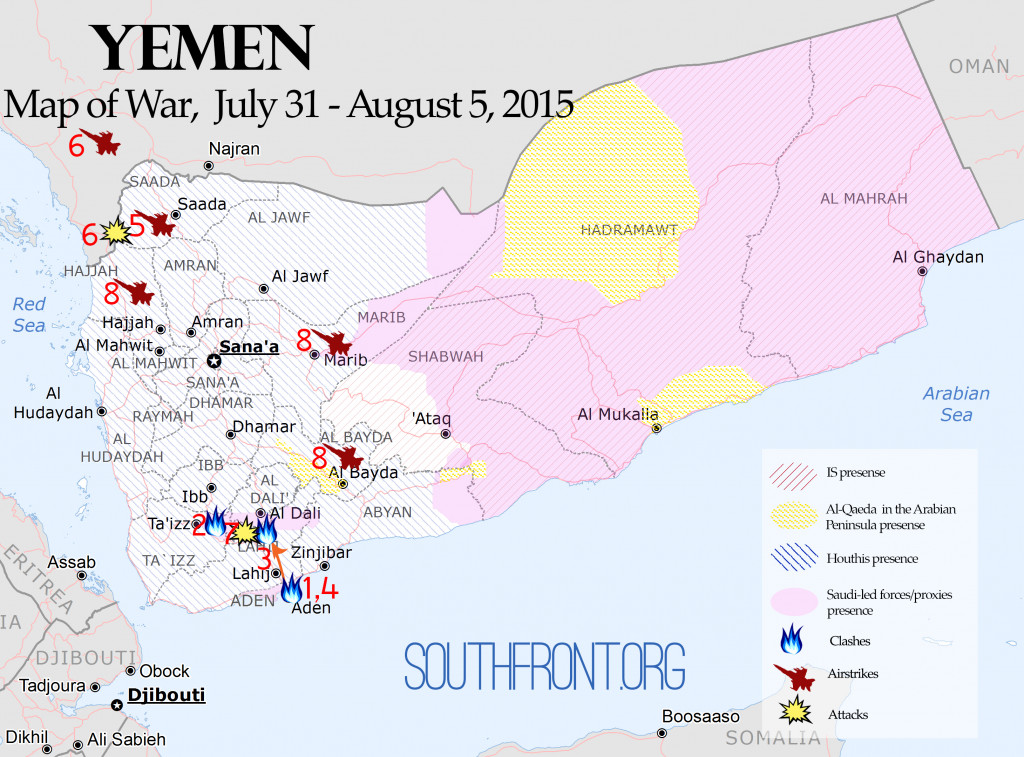In the early August, the Saudi-led coalition officially invaded Yemen. At least 3000 coalition troops with military equipment deployed in Aden as part of the second offensive of “Operation Golden Arrow” to roll back the territory held by the al Houthi government. The Yemeni government has been deploying fighters in Aden and Taiz where Saudi-led forces are focused. Al Houthi-linked attacks along the border with Saudi Arabia have increased.
- July 31 – August 3, The Saudi-led coalition officially deployed what is reported to be a brigade of tanks and other armored vehicles to boost the fight against the Yemeni government. A Total of around 3000 troops, primarily from the UAE, with military equipment landed in the southern port city of Aden. In late July, the port officials in Aden already reported the arrival of medium and heavy weapons to arm the anti-al Houthi militias fighting there.
- August 2, Al Houthi leader Abdul Malik al Houthi called for his supporters to continue to fight, describing the success of the Saudi Arabia-led “Operation Golden Arrow” as a limited achievement and that the offensive would “collapse.” According to reports, the Yemeni government has been continuing a deployment of fighters into Taiz and Aden, where the Operation Golden Arrow offensive has focused.
- August 2-4, Pro-Hadi forces assisted by ground troops from Saudi Arabia and the United Arab Emirates (UAE) have been preparing for a “final push” to recapture al Anad military base in Lahij governorate. The al Houthis and Saleh loyalists have held al Anad military base since the end of March. The base itself controls the primary road north from Aden city.
- August 3, At least one Saudi soldier was killed during clashes between Yemeni forces and Saudi forces in the Aden province. Meanwhile, Yemeni forces stormed the Saudi military base of Makhroq after hitting it with artillery fire in retaliation for the Saudi onslaught against the country.
- August 3, Saudi fighter jets targeted the Hidan and Sahar districts of Yemen’s northwestern province of Sa’ada.
- August 4, The Yemeni forces fired mortar shells at Saudi military positions in the al-Tawal district, the al-Dood military zone and the village of Khobah in Jizan Province, inflicting losses on Saudi military equipment and forcing the troops there to leave behind their positions. The Yemeni media also reported the allied forces fired rockets at the al-Jihad military zone in Jizan, Arrabeh and Rabouah zones in the Zahran district in the southern Saudi province of Asir.
- August 5, The UAE and Saudi troops supported by pro-Hadi militants pushed north, attacking the strategic Al-Anad air base from several sides. Then, Pro-Saudi sources reported that the Saudi-led coalition took control on the airbase. However, the Yemeni media stated that al Houthi fighters successfully repealed the attack.
- August 5, Saudi warplanes conducted a series of airstrikes against Yemen’s central province of Ma’rib, Hajjah Province in the northwest and the southern province of Bayda. At the same time, the Yemeni media reported that the Yemeni army’s air defense forces downed the helicopter with a surface-to-air missile in the district of Harad in the western province of Hajjah.
The arrival of UAE and Saudi troops and military equipment in Yemen represents a significant escalation in the military campaign against the Houthi government which has struggled to roll back their territorial gains. Fighting now focuses over control of the Yemen’s largest air base, Al Anad.
An interesting fact is that Saudi Arabia and its allies have decided to commit more of their own resources in the fight against the Yemeni government in power. It’s widely known that Saudi forces, essentially mercenaries, don’t have a successful experience in full-scale land operations. Here are the possible reasons of the coalition’s decision:
- The “gains” of pro-Hadi militants without support of the coalition are more a PR campaign than real victories.
- The presence of additional foreign troops may be an attempt to show the strength of Hadi’s government and discourage southerners from seeking to fully secede.
Despite the hard situation in the country, the al Houthis continue to push forward with governance plans for Yemen and recently announced plans to construct an oil port with an initial capacity of 500,000 tons in al Salif district in al Hudaydah, near the Ras Isa floating export terminal.
The focus on the dynamics between the Yemen government and the Saudi-led coalition distracts from activities of terrorists, which continues to exploit the crisis to expand its presence in Yemen. ISIS’s Wilayat Aden has released its first report on service-provision in Yemen. A photo set entitled, “Health Services: Visit to the Medical Center of Office of Health,” on July 28 shows care giving to patients in a room with the black flag with the shahada hung in it. It’s the first evidence that ISIS is attempting to provide services to Yemenis. Therefore, ISIS seeks additional support of locals in Yemen.
See for additional information about the developments in the region:
- Yemen Map of War, July 22-30, 2015
- Yemen Map of War, July 18-21, 2015
- Yemen Map of War, July 14-17, 2015
Supply SouthFront newsammo units for more struggle for the truth
(Do you like this content? Help SouthFront make more!)




